Fungal infection is very commonly affects the toes or fingernails. This disease affects adults and children. To avoid transfer of disease in a chronic form, need to know the signs of foot fungus and how does such a disease.
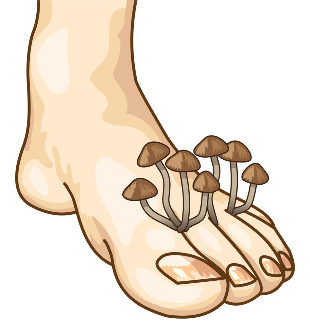
The main symptoms of the disease
Among all the skin diseases athlete's foot is the most common. To disease can, ignoring elementary rules of hygiene. To cure the fungus can sometimes be very difficult.
Each person has a foot fungus begins and develops in its own way. Here are the most common signs that you can recognize athlete's foot:
- between the toes there are typical cracks;
- to understand that there is a fungus that can be a characteristic itch on the feet and between the toes;
- the skin is very dry, often scaly and coarse;
- between the toes blisters, which burst in the destruction;
- the infection can pass to the neighboring areas;
- the skin appear red spots, which cause significant discomfort;
- to know athlete's foot can and unpleasant smell.
Signs of the fungus depending on the type of pathogen
This disease develops due to different types of pathogens. The symptoms of the feet will differ in each case.
- If the foot develops a yeast fungus, the nail gradually becomes thinner and pulls away from the bed. The skin on the feet hyperemia (becomes tinged with red).
- With the development of the fungus the nail turns yellow, covered with spots. The skin of the feet peels off, it emits an unpleasant odor. The characteristic symptom of this type of fungus is increased dryness of the skin.
- The mould of the nail plate can dramatically change your color. The skin becomes red, if the pathogen pathology is gradually moving to the whole foot. Man worried about itching, the skin can crack. In this case, during walking there is pain and other discomfort.
To determine the type of the pathogen can only be a doctor. At home it can be done. And if you practice self-treatment, you can only hurt yourself. Will suffer from it foot and skin fungus will spread more and more.
Signs of some forms of fungus
Depending on the affected area and extent of development there are several forms of pathology. The symptoms of each differ. Knowing the early signs of the disease legs, possible early treatment of mycosis.
- Interdigital Dermatophyte is the most common disease. She aktiviziruyutsya in spring and summer, when feet sweat more. Between the toes cracks and ulcers. It is possible to notice the presence of skin flakes. The foot looks perfectly healthy. Often the person feels itching.
- Erased form appears in the least marked degree. Between the toes is noticeably peeling. At this stage of the disease from the feet apply a sharp odor: it appears due to the increased activity of bacteria.
The disease can occur in various forms. Take a look at their features to know how to identify fungus on the feet and in case of its development to begin treatment. You need to remember that at advanced stages of the disease the nail is completely destroyed. To restore it is almost impossible.
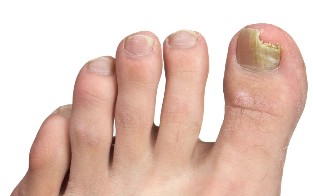
Flake type
For such a fungus characterised by an intense exfoliation of the epidermis. The most intensively affected is the skin between the toes and side of the foot. The signs of the inflammatory process do not exist. The photo of the first signs of foot fungus visible areas of hyperemia. Scaly fungus looks like this:
- thickened stratum corneum;
- skin is shiny, it sometimes becomes thick;
- the pattern on the skin becomes more expressive;
- the fungus is gradually spreading to the toes, whole foot, affects the nails;
- sometimes on the epidermis appear lamellar scales;
- other discomfort the patient is experiencing.
Chronic type
When this fungus appears on the skin small blisters filled with fluid. Usually they are in the lateral part of the foot. Then they gradually move on to the inner side of the fingers. How to recognize fungus chronic:
- the bubble is usually solitary, but if a lot of them, they merge into one big;
- if untreated, the fluid in the vesicles gradually darkens;
- if the bubble bursts, it appears the erosion crust.
Intertriginous type
This type of fungus is the most common. First, a person does not feel any symptoms. Up to a certain point, the skin on the toes does not change. Further cracks, layering. The skin is not damaged, but it can be sweat.
The incidence of athlete's foot
Characteristic symptoms of this fungal infection the following:
- the lesion is the 3rd or 4th toe;
- the skin is red and swollen;
- around the lesion is a vesicle, where there is a detached layer of skin;
- nearby are the pustules that bubbles.
Signs of fungal nails
The person may be affected and the nails of the feet. To distinguish the disease by the following symptoms.
- Pronounced discoloration of the nail plate. Depending on which type of pathology the patient, the nail acquires a variety of colors. Sometimes it can only be changed on part of the nail plate.
- Crumbling of the nail. It is only at advanced stages. If the nail is completely infected, it is destroyed.
- Changes in the structure of the nail.
There are several types of onychomycosis — fungal nails.
- Atrophic appearance. The nail plate looks very thin. It darkens, sometimes becoming grayish-brown color. The nail is gradually peeled from its bed. The skin under it becomes rough and loose.
- When the normotroficheskie type of fungus of the feet plate changes its color. Her spots appear white, yellow, green and even black. The structure of the nail does not suffer.
- In hypertrophic, the plate gradually thickens, becomes porous. The affected area looks very ugly and in some cases is the cause of pain while walking. The sides it crumbles and is destroyed without treatment.
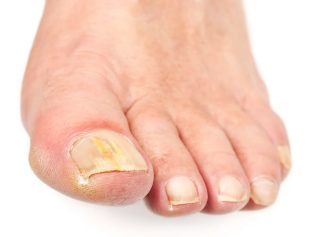
Some types of onychomycosis
Depending on the degree of spread of the disease distinguish the following its form.
- Lateral onychomycosis is the most common. On the free edge of the nail appears at first a small yellow spot. In the future, you can see how it gets larger, and the nail plate thickens. While walking, the person feels discomfort. Noticeable odour. Lateral onychomycosis is difficult to treat.
- Superficial onychomycosis is characterized by involvement of only the upper layers of the plate. It is not thickened, but eventually it becomes like chalk.
- The most rare form of the disease is subungual onychomycosis. The skin is visibly thickened in the nail folds. The nail turns white and loses its transparency.
Risk group
Actually, "catching" the fungus you are taking a risk anywhere — even at home. But in public, of course, the chances are much greater (if not careful).
Who is at risk?
More at risk of catching the fungus people with such diseases:
- Flatfoot and talipes.
- Impaired blood flow.
- Excessive sweating feet. Often the fungus get a grip of athletes and military, which due to the nature of work have to go in tight or uncomfortable shoes even in the heat.
- The presence of corns on the feet, as well as people with rough and thick skin on the feet.
- Low immunity.
- The presence of chronic diseases.
- Frequent injury of the skin around the nails or the nail plate. This category can be attributed to the fans of pedicures in salons or people who disregard the rules of hygiene.
- Diabetes.
General principles of treatment
Any treatment begins with the diagnosis. Only then can be assigned suitable means. Self-medication usually leads to deterioration of the feet. Take a look at the most common methods of therapy.
- At the first signs of fungal infection apply special varnishes, plasters, ointments, and sprays. They need to be used for a long time and according to instructions.
- The ineffectiveness of local therapy administered antifungal drugs with complex action. They are used orally.
- Surgical removal of the affected nail.
- Laser therapy.
- When the advanced form of the disease is prescribed systemic medications.
To avoid unpleasant disease, observing the rules of hygiene. You should avoid using other people's personal hygiene (towels, Slippers). When the first signs of the disease should immediately consult a doctor.
The 10 best folk remedies for nail fungus
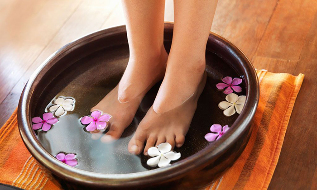
If you suspect the nail fungus at the same time as treatment with a specialist, you can apply one of the traditional methods. Not recommended it instead of treatment by a doctor— you risk to aggravate the problem and then the healing process will be long and tedious.
So, what tools came to us from our grandmothers and great-grandmothers?
- Regular treatment of nails, one of the following: propolis tincture, antiseptic tea tree oil, Apple cider vinegar.
- The foot bath.You can use sea salt (preferably without additives), infusion of celandine, yarrow, Hypericum, oak bark, chamomile, calendula etc. After the bath should lubricate the nails with lemon juice, iodine or Apple cider vinegar.
- Iodine. The essence of treatment: twice a day apply it on the damaged nails (over 20 days) 1-2 drops of iodine. If successful, the treatment then go for the treatment for 1 every 3 days.
- Kombucha. Its infusion is used as compresses. It is sufficient to impregnate the gauze, apply a compress and leave on overnight under plastic and socks. Also can be applied directly to the part of the tea fungus to the nails, after which they should be bandage and leave for a couple of hours. After you steam the feet and apply a mixture of Apple cider vinegar (part 1), alcohol 96% (2 parts), glycerin (2 parts). To leave for the night. The course of treatment — 2 weeks.
- The garlic oil.Pour the grated garlic in hot oil to fully cover the garlic. All mix, cover and leave for 2 days. The essence of treatment: wetted swab in the oil applied to the sore area, put a bandage protected the top with polyethylene, put on socks and leave overnight. The course is 2 weeks.
- Vinegar.Wetted swab in vinegar (9%), applied on the affected area, wrap with plastic, fix with a bandage and leave overnight. In the morning we repeat.
- Soda with celandine. Soar feet in a solution (3 liters of water + 1 tbsp/l of soda), wipe the feet with affected areas together with the fingers oil celandine (look in the pharmacy). The course is 2 weeks.
- Birch tar. Up feet with the use of household/Soaps (about 20 min), clean the feet with a pumice stone, trim the nails, wipe dry the legs and lubricates the nails with your fingers birch tar. Feet put on the newspaper by 1.5 hours and read the book. Next, remove the excess tar with a bandage, wear cotton socks and forget at the legs for a couple of days. After my feet again with khoz/soap in cool water. In the evening repeat the procedure. The course is 2 weeks.
- Kalanchoe. Treatment: on the unpainted nail glue with patches of the leaves of Kalanchoe to cover them with nail holes. Patches leaves are changing daily. Course — 2-3 weeks.
Prevention of nail fungus
To protect yourself from fungus can be a simple observance of rules of hygiene and preventive measures.
Remember:
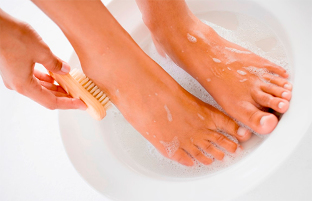
- In all public areas (beaches, shower, locker room, pool, Spa-salons and other) wear washable Slippers. Do not go barefoot where there is a risk of catching an infection!
- Do not wear other people's shoes (including Slippers away — better to walk around in socks).
- Do not use other people's towels and manicure instruments.
- Getting out of the bath, put his feet on common (and often wet, not the first freshness) the Mat and on his own towel (pre-select it for such a purpose).
- Regularly inspect the feet and nails on the subject of signs of the fungus. At the slightest symptoms (there were cracks/itching between the fingers, change the color of the nail, etc.) measures. That is, acquire ointments, special/lucky, etc
- Try not to use tight, narrow shoes and shoes made from poor quality materials.
- Regularly treated your shoes inside antiseptics.
- To feet did not sweat, use deodorants, talc, etc
- Use only cotton socks. If you want to use tights/stocking (manufacture of nylon and other synthetic fabrics) they must remove the house, up the legs treated.
- In the heat wear open shoes — for ventilation and free air exchange. Sweaty feet — soil for bacteria.
- Do not measure for footwear without socks/footprints— barefoot.
- Wipe feet dry after the bath including between your toes — that's where the fungus starts.
- Don't allow cracks on the feet, use moisturizers.
- My feet with antibacterial soap.
- At high risk of infection (for example, on holiday or in the pool) used antifungal creams, powders or sprays.
- Thoroughly dry the shoes, if it got wet. Do not wear wet shoes/boots.
- Choose only proven salons for a pedicure/manicure.
- Do not allow ingrowth and nail deformation — measures in a timely manner.





























